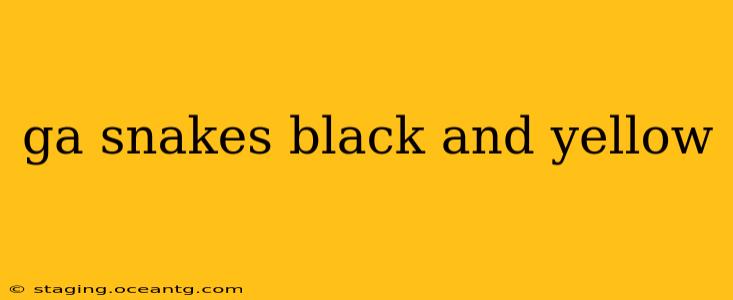The striking black and yellow stripes of certain snakes immediately trigger alarm bells for many people. While the vibrant coloration is undeniably eye-catching, it’s crucial to understand that it's a warning signal, often indicating venom. This guide will help you identify some of the venomous snakes with this distinctive pattern, focusing on those commonly referred to as "ga snakes," understanding this term is generally regional and less precise than using scientific names. We'll explore key identification features and dispel common misconceptions to ensure safety and responsible wildlife observation.
What Snakes are Black and Yellow? (Focusing on "Ga Snakes")
The term "ga snake" is often used colloquially and regionally to describe various snakes with similar appearances. This can be confusing, as different species might share some visual similarities but have crucial differences in venom potency and behavior. To avoid ambiguity, we will focus on species known for their black and yellow banding that are frequently referred to by this informal term.
Remember, never handle any wild snake. Identification should be done from a safe distance, ideally using binoculars or a camera with zoom capability.
Eastern Coral Snake ( Micrurus fulvius)
This is a highly venomous species often confused with non-venomous mimics. The Eastern Coral Snake exhibits distinct bands of red, yellow, and black. Crucially, the red bands are adjacent to the yellow bands. This is a key distinguishing feature separating it from harmless imitators. The bands are narrow and complete, encircling the body.
Western Coral Snake ( Micruroides euryxanthus)
Similar to its eastern counterpart, the Western Coral Snake also displays red, yellow, and black bands. Again, the red bands touch the yellow bands, differentiating it from harmless look-alikes. This species is smaller and its coloration can vary slightly geographically.
Other Black and Yellow Banded Snakes
While coral snakes are the most notable examples of black and yellow banded venomous snakes, other species in different regions might display a similar color pattern. These often represent variations in banding patterns or might only partially exhibit black and yellow. Accurate identification requires considering the entire geographical region and detailed physical characteristics. Always consult local wildlife experts or herpetological resources for precise identification.
How Can I Tell the Difference Between Venomous and Non-Venomous Black and Yellow Snakes?
This is a crucial question, and relying solely on color patterns can be dangerous. Many harmless snakes have evolved to mimic the coloration of venomous species to deter predators (Batesian mimicry). Here's how to better distinguish them:
Look at the Band Arrangement: In coral snakes, the red bands touch the yellow bands. Mimics often have red bands adjacent to black bands.
Examine the Head Shape: Venomous snakes often have a distinct head shape, which may be triangular or more robust compared to the slender heads of many non-venomous species.
Consider the Location: Knowing the geographic area helps narrow down the possible species.
Don't Rely on Size: The size of a snake doesn't reliably indicate its venomous status.
Seek Expert Identification: If you are uncertain, photograph the snake from a safe distance and consult a local herpetologist or wildlife expert for accurate identification.
What Should I Do if I See a Black and Yellow Snake?
Observe the snake from a safe distance. Avoid any contact or attempts to handle it. If you need to move through an area where the snake might be present, proceed cautiously and carefully scan the surroundings before you step. If you are bitten by any snake you suspect is venomous, immediately seek medical attention.
Are Ga Snakes Aggressive?
The aggressiveness of any snake species varies. Coral snakes are not typically aggressive but will strike if threatened or cornered. As with all wildlife encounters, observe from a safe distance and allow them to go about their natural behavior.
Where Do Ga Snakes Live?
The geographic range varies depending on the species. Coral snakes are predominantly found in southeastern North America and parts of Central and South America. This necessitates researching specific species based on the location for more precise habitat information.
Remember, responsible wildlife observation involves appreciating these animals from a distance while prioritizing personal safety. Always use caution when encountering any snake, especially those with warning coloration. Accurate identification is crucial, but if you're uncertain, err on the side of caution and seek expert help.
